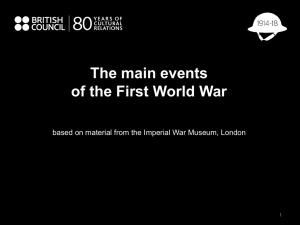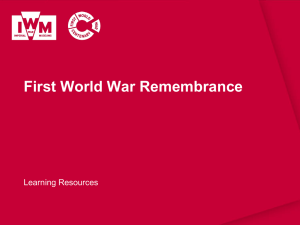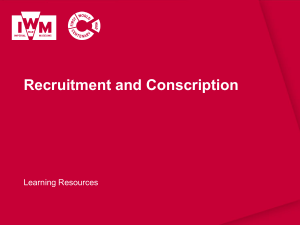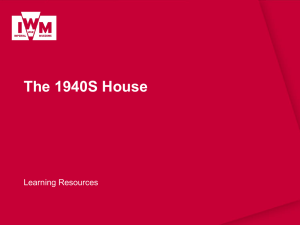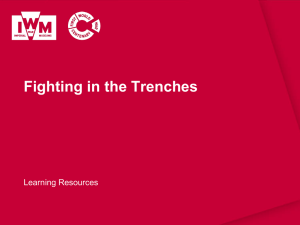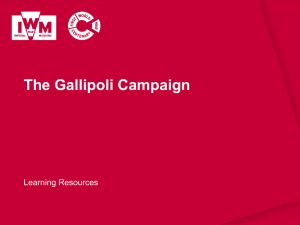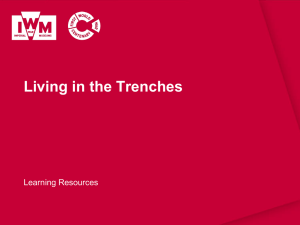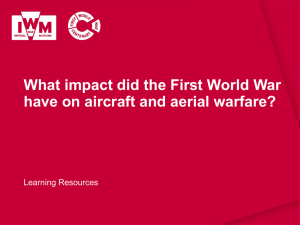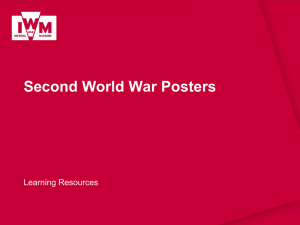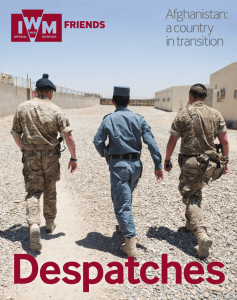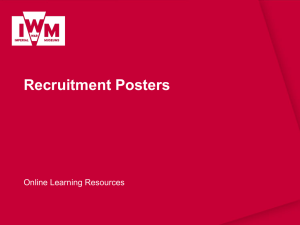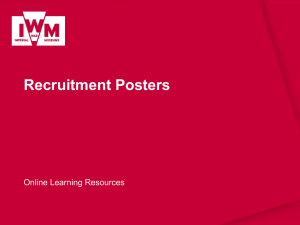PowerPoint Template 3 October 2011
advertisement
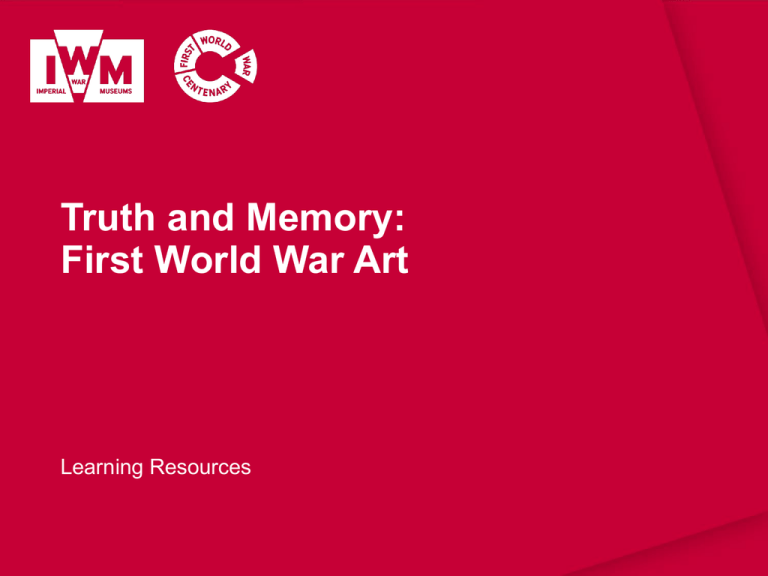
Truth and Memory: First World War Art Learning Resources IWM Learning Resources: Terms of Use • The images in this resource can be freely used for non-commercial use in your classroom subject to the terms of the IWM’s Non Commercial Licence: http://www.iwm.org.uk/corporate/privacy-copyright/licence • You can use the full presentation or use individual slides within other presentations for use within school and to share with other teachers for their non commercial use as well. • You can print the images out up to A4 size if you wish to use hard copies with your class. • Each image comes with an attribution statement, which must be included wherever the image is used. For example, © IWM (Art.IWM ART 1179). • Every effort has been made to contact all copyright holders. IWM will be glad to make good any error or omissions brought to their attention. • By downloading this PowerPoint and using these images you agree to these terms of use, including your use of the attribution statement specified for each object by IWM. © IWM (Art.IWM ART 1656) 'Over The Top‘ by John Nash During the First World War the British government developed a variety of art schemes to record and document all aspects of the conflict from the violence of the fighting fronts to the social and industrial change at home. Art was seen as the means to convey the righteousness of Britain’s cause, to bear witness to the experience of war, to remember the fallen and provide effective propaganda. The images which were produced continue to shape our interpretations of the First World War. © IWM (Art.IWM ART 6492) Blood and Iron by Charles Ernest Butler Some early artistic responses to the war were unconvincing; some showed unrealistic scenes of hand-to-hand combat and cavalry charges in a style more associated with the Napoleonic or Crimean Wars of the 19th century while others used outdated religious and jingoistic imagery. Charles Ernest Butler’s narrative painting “Blood and Iron” depicts Christ comforting Belgium while the German Kaiser glances coldly on with the angel of death on his shoulder. © IWM (Art.IWM ART 2747) A Battery Shelled by Percy Wyndham Lewis Many artists and critics felt traditional methods of painting war could no longer provide an adequate or “truthful” representation of the conflict. The unfamiliar and highly industrialised nature of modern warfare led to new and experimental artistic responses. Percy Wyndham Lewis’ Vorticist painting of a British artillery battery being shelled depicts a strange scene where soldiers appear dehumanised and insect-like. © IWM (Art.IWM ART 725) The Doctor by C R W Nevinson Artists who had witnessed the front line were seen as uniquely placed to deliver an authentic portrayal of the war. CRW Nevinson’s initial support of the war was challenged by his experiences as a medical orderly and ambulance driver in France. In this painting he portrays a doctor tending an injured soldier in a makeshift casualty centre outside Dunkirk. The awkwardly bent pose of the figure in the background and use of red throughout the painting stresses the terrible human cost of the conflict and its un-heroic nature. © IWM (Art.IWM ART 15661) The Kensingtons at Laventie by Eric Kennington This painting was one of the first based on first-hand experience of the conflict seen by the British public. It received huge public acclaim and generated much sympathy for the British soldiers on the Western Front. The image shows Kennington's regiment, known as ‘The Kensingtons’, halting for rest at the French village of Laventie after leaving their frontline trenches. To emphasize his presence at the scene, Kennington included a portrait of himself, background left, wearing a black balaclava. © IWM (Art.IWM ART 2962) Mines and the Bapaume Road, La Boiselle by William Orpen Depicting the landscape of the Western Front was problematic for many artists. Long range artillery fire and the system of trench warfare meant that these spaces were rendered featureless. Nevertheless, there was a unique character to the landscape of the Western Front. William Orpen’s painting focuses on chalky soil of the Somme area of France. Churned up by shell-fine and mines and baked white in the spring sun of 1917, it generated an unworldly scene like a lunar landscape. © IWM (Art.IWM ART 1150) The Field of Passchendaele by Paul Nash The battered and scarred landscape of the Western Front had a profound effect on many artists. For Paul Nash the shelled woods, dismembered trees and traumatised fields became a metaphor for the wider destruction and suffering of the war. Depicting nature in this way became a means of understanding the war and modernising landscape painting. © IWM (Art.IWM ART 2271) Shop for Machining 15-inch Shells by Anna Airy Artists also played a role in documenting the effect of war on the Home Front, particularly on women’s lives. Here we see an interior view of the workshop in the Singer Manufacturing Company, where the majority of workers were women. During the First World War the factory switched from making consumer goods to armaments. Anna Airy was commissioned to produce four paintings depicting munitions production and here we see the women producing 15 inch shells for battleships. © IWM (Art.IWM ART 2288) ‘Voluntary Land Workers in a Flax-field by Randolph Schwabe Naval blockades severely disrupted agriculture and food distribution during the First World. The war had also taken many men and horses away from agricultural work so finding a new workforce to farm the land became extremely important. The Women’s Land Army was established in 1917. In this painting women are shown collecting flax which was especially important in aircraft manufacture. © IWM (Art.IWM ART 4655) Youth Mourning by George Clausen Many artists tried to capture the private emotion of war, especially if they had served at the Front or if they were personally affected in other ways. In this painting by George Clausen, the naked woman, representing Youth, kneels in grief before a wooden cross marking a grave. In the distance are the flooded craters of a battlefield. The painting is Clausen’s personal response to the First World War, in particular the death of his daughter’s fiancé. This depiction of private grief, however, also conveys a wider sense of a nation in mourning. © IWM (Art.IWM ART 4438) To the Unknown British Soldier in France by William Orpen At the end of the First World War artists and sculptors increasingly turned their attention to public expressions of remembrance. Among these was William Orpen, who during the war had painted portraits of generals and the young pilots of the newly formed Royal Flying Corps. In this painting which was one of three works painted to mark the Peace Conference in Paris in 1919, Orpen deliberately focuses on the “forgotten” ordinary soldiers rather than the politicians he saw arguing over the peace terms. © IWM (EPH 4203) Public remembrance This moneybox is made using wood from the temporary Cenotaph which was originally erected for the London Victory Parade in 1919. The temporary Cenotaph was later replaced with a permanent stone structure which was unveiled on 11 November 1920. The moneyboxes were decorated with a clock face showing the hands at 11 o’clock, to mark the moment when the 1918 Armistice came into force. They also bear three flags signifying the three branches of the Armed Forces. © IWM (Art.IWM ART 2287) The Battle of Ypres: The Worcesters at Gheluvelt by Charles Sargeant Jagger In February 1918 the British War Memorials Committee was established to create an artistic memorial to the nation’s effort and sacrifice. Sculptural works like this one were also planned for inclusion in a Hall of Remembrance which would house the collection. Due to lack of funds the Hall was never built and the works were given to the Imperial War Museum. Today they continue to inform how we commemorate conflict and have helped to build the visual iconography associated with the First World War. Truth and Memory: First World War Art Learning Resources
